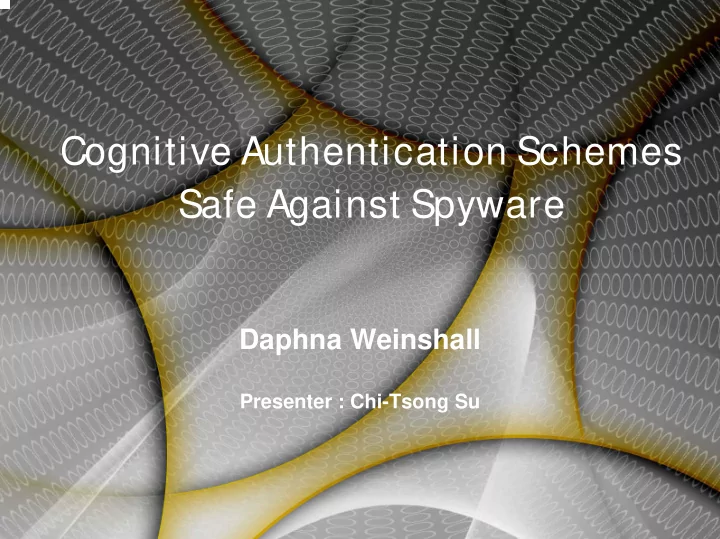

Cognitive Authentication Schemes Safe Against Spyware Daphna Weinshall Presenter : Chi-Tsong Su
Do you know … . � How many things do you have to remember immediately or permanently? � Telephone Number � Social Security Number � Vocabulary � Name � Card Number � ……. • Let us test how well you can remember things
Contract Bridge � Playing Contract Bridge requires moderate memory capacity on text • Played Cards, Play Process, Bidding Process � Basic Play Rule in a No-Trump Game • 13 Tricks in a play with 4 players • The first card played in a trick by a player is called the lead, and the remaining players play a card clockwise around the table by following the same suite • The hand that plays the highest card in the suit of the lead wins the trick • A>K>Q>J>10>………. • Any card can win a trick if with the same suite ,no other card is higher than it. This also holds when no other card with the same suite appears. • A Complete Play • Test1 Test2 Test 3
What if we ask you to recognize pictures , rather than text? � How do you recognize a person? � Usually, we recognize his face first, and remember his name � Outline, hair, eyes, nose, mouth, voice and other features � There exists an association between a face and a name � How do you recognize a picture? � The story hides underneath the picture � Only people who have seen it can construct a pattern for recognition � Geared in Security � It is not easy to present all associations within a short time � Even though these associations are randomly ordered in a sequence, the complexity of the sequence is less complicated to users than to attackers
What is the difference between recall and recognition in authentication? � Recall: � Involves digging into memory and bringing back information on a response basis � Example: � What is the capital of England? � Who is the first human that walked on the Moon? � Authentication: Knowledge-based systems � Need precise recall with passwords � If passwords are simple to remember, they are also vulnerable to attack � If passwords are complex and arbitrary, they are difficult to remember
What is the difference between recall and recognition in authentication? (Cont.) � Recognition: � a process that occurs in thinking when some event, process, pattern, or object recurs � People are much better in imprecise recall , and its capacity is limitless � Example: � Facial Recognition � Pattern Recognition � Handwriting Recognition � Flawed if it is implemented alone in authentication � Weak under attacks of cumulative observations with powerful resource � If recognition-based authentication combine with interaction in a proper way ,this protocol is difficult to break
Problem � What are the issues of the current authentication protocols? � Token-Based Protocol � Forgeable � Missing Token � Guessing Attack? � Knowledge-Based Protocol � Simple knowledge means vulnerability � Complex knowledge is considered as impractical � Biometrics � Devices can be unpleasant to users � Graphic Password Schemes � Easier to remember , but not safer than regular password against eavesdropping
How should we customize this system? � This system itself should generate a set of randomly selected pictures proposed for authentication � Other than graphic passwords, we need add some questions in the pictures to ensure that the passwords are not guessable � We have to trade-off login time and training time � This system can decide whether to authenticate users or reject them by the accuracy rate at which they respond to a challenge protocol
Methodology � Challenge Response Protocol � A set of B of N common pictures generated by the system , rather than by the discretion of the user � A set of randomly selected F B of M <N pictures � Unlike some other protocols, e.g. Deja vu, the user is asked a complex or simple multiple-choice question with P possible answers about the random set in addition to a set of picture challenge. � High Complexity Query :N= 80, M=30, P=4 � Low Complexity Query :N=240, M=60, P=2 � With accuracy higher than pre-fixed threshold as to exclude random guessing, the system authenticates the user. � How about the price? � It takes a lot of time to train users for recognizing a bunch of pictures and know the story underneath the pictures
H ~ # bits H ~ N M P Query Size # bits H^ 80 30 4 8*10 8.87141E+21 72.90965 47 Results 120 50 2 8*10 1.83617E+34 113.8223 84 95 40 8 8*10 9.9718E+26 89.68798 47 145 55 4 4*5 4.26646E+40 134.9702 47 � Security � Resistance to various attacks � Eavesdropping � Brute-force Attacks , unless attackers have powerful resources � Enumeration Attacks � Success Rate � After undergoing three training sessions on three consecutive days, all participants had the success rate over 95% per query � Many participants had perfect memory retention in last trail � Time needed in authentication � 3 minutes in high complexity protocol � 1.5 minutes in low complexity protocol
Take-Away � We can combine recognition-based and recall-based protocol for authentication � Even though this protocol is Human-friendly, it is not practical in emergency
But … … … � Is it worth training a user for 3 days? � Is there any other scheme able to reduce training time � How about the overhead of this system? � How far can we go with imprecise recall for authentication? � Is memory of recognition influenced by re-store memory with subtle difference ?
Recommend
More recommend